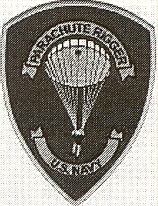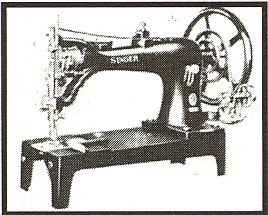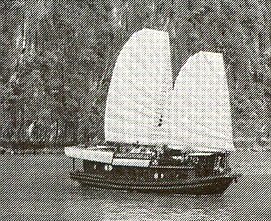“The AJ Saga Continues--The Rest of the Story” *
 The AJ 2 was the Navy's answer to the Strategic Air Command, and was essentially a multi engine, carrier based plane designed around a bomb bay large enough to carry the early fat "nukes." Because of its multi engines (two recips and a single jet aft) and long range navigation requirements, the Navy decided to integrate a percentage of multi engine gents who could contribute their experience in those two fields. After all, the theory went, the multi folks wore wings of gold too and were therefore experienced in the ways of carrier aviation.
The AJ 2 was the Navy's answer to the Strategic Air Command, and was essentially a multi engine, carrier based plane designed around a bomb bay large enough to carry the early fat "nukes." Because of its multi engines (two recips and a single jet aft) and long range navigation requirements, the Navy decided to integrate a percentage of multi engine gents who could contribute their experience in those two fields. After all, the theory went, the multi folks wore wings of gold too and were therefore experienced in the ways of carrier aviation.
The fact that this experience had been gleaned some years earlier, from six arrested landings in an SNJ at the training command, did not diminish the enthusiasm for this idea. Anyway, as their part of the two way bargain the "hookers" would pass on the lore of the carrier deck and all would be well. And now, to paraphrase Paul Harvey, let's hear "The Rest of the Story."
Following a tour flying four engine PB4Y-2 Privateers with Heavy Patrol Squadron Twenty Six (VP-26) and a tour at the Naval Air Training Command at Pensacola, Florida, I reported to an AJ squadron (VC-6) in San Diego in 1953. For the first half of the three year tour I served as a bombardier/navigator. This was standard practice then, but I finally qualified as a plane commander. Checking out the new pilots was done at the squadron. The usual fam flights were followed by bushels of Field Carrier Landing Practice (FCLP) and then on to final quaIs on the carrier. No big deal. Everything on the carrier was done at minimum weight to facilitate turnaround. All qualification landings were done during the day and, very often, to save time the planes were deck launched rather than launched by the catapult. However we did do a few catapult shots just to learn the procedure, and the procedure was not difficult.
You were positioned on the catapult, the aircraft was hooked up to the big under-deck machine, the check off list was completed, and then, when your turn came the catapult officer would hold three fingers up, wave his hand in a circle and you would advance the throttle on the jet. Jets take longer to wind up than recips. When the jet was humming smoothly at full throttle, the cat officer would hold up two fingers, wave his hand in a circle and you would advance the throttles on the two recips. Now, with everything going at full throttle and with the instruments indicating that the engines were functioning correctly, you would salute with your right hand, again grab the throttles and a fixed bar in front them, and you would be catted off. The fixed bar as there so that your hand would not accidentally slip backward and reduce power. This could happen, the cat shot was a real kick in the tail.
Just prior to deployment, there was the operational readiness inspection (ORI) which required a simulated mission from the ship with a night launch, a full load of fuel and a "shape" in the bomb bay substituting for a real nuke. Total weight something just above 53,000 Ibs. This was a new requirement … something we had not had to do when I was flying as bombardier/navigator.
When our big day came there were two crews ready to qualify, and the other plane also had another ex-multi pilot as plane commander. The launch was set for 0300. To add to the fun the weather was stinko with about a 300 ft. ceiling, gnarly seas and light rain. The AJ-2 was a big bird and at launch time, when two of them sat on the catapults, the wings overlapped. I was on the port cat in the number two launch position and so I had a good chance to observe my opposite number in the other plane.
 The catapult officer gave him the three finger turn up telling him to full throttle the jet, and then with that burning, the two finger turn up told him to full throttle the recips. So far, so good. I watched his bombardier point the red flashlight at his face, watched him salute and nothing! Once again, red flashlight at his face, salute nothing! Meanwhile sparks were shooting out aft, his plane was shaking, and he was ready. I wondered, why they didn't cat him? Again, the flashlight, the salute, and no dice. Finally I heard him call on the radio, "I have saluted this guy three times and he won't launch me. What's the matter?" The answer came down, "He wants you to turn on your running lights!" Well that made sense. We were just outside San Clemente Island and would have to transit the Los Angeles control area to the Salton Sea to drop our bomb. Of course we would have to have running lights. His lights came on and off he went.
The catapult officer gave him the three finger turn up telling him to full throttle the jet, and then with that burning, the two finger turn up told him to full throttle the recips. So far, so good. I watched his bombardier point the red flashlight at his face, watched him salute and nothing! Once again, red flashlight at his face, salute nothing! Meanwhile sparks were shooting out aft, his plane was shaking, and he was ready. I wondered, why they didn't cat him? Again, the flashlight, the salute, and no dice. Finally I heard him call on the radio, "I have saluted this guy three times and he won't launch me. What's the matter?" The answer came down, "He wants you to turn on your running lights!" Well that made sense. We were just outside San Clemente Island and would have to transit the Los Angeles control area to the Salton Sea to drop our bomb. Of course we would have to have running lights. His lights came on and off he went.
I gave instructions to my bombardier, Karl Sams, to be certain to flip on the navigation lights as the last item on his check list. Now, with the first plane gone, attention was shifting to us. On board my plane all three engines were purring away in idle and the final check lists were nearing completion. The cat officer raised his arm displaying three fingers and began waving them in a circle. I pushed the jet throttle forward watching the instruments and listened while the jet wound up to max power. My hand dropped back to the recip throttles, and that was when Karl flipped on the nav light switch. WHAMO! We were on our way. The lights were the signal that we were ready to launch!!! We still should not have gone until the catapult officer gave the signal, but I guess whoever pushes the cat button wasn't watching the catapult officer and just reacted instinctively to the lights. No matter, there we were, heading for the blackness off the bow with the recips in idle and only the jet and the cat pushing that 53,000 pound aircraft to launch speed.
I slammed the recip throttles forward with my right hand while hanging on to the control wheel with my left and we were on our own. Forget about grabbing the fixed bar I was leaning into the throttles and watching the instruments to keep the wings level and maintain flying speed. My pals who were watching said that we dropped out of sight and all hands thought we were lost. But then out of the void came the trail of sparks from the engines and we went straight up into the overcast. I can now only conclude that we were launched at a peak upswing of the bow, but I'll bet my landing gear only cleared the water by inches or perhaps even touched it.
* Flying Midshipmen LOG, winter 2008; © 2008.
“Report to the Parachute Loft !” *
I enlisted in the Navy in late 1943 to become a Naval Aviator. I was sent to Brown University in January 1944 for three semesters to prepare me to be an officer. All candidates for flight training had the same experience and, of course, all graduated from the university at the same time. The trouble was that the three pre-flight schools around the nation could not absorb all of us at once.
Instead we were sent off to various temporary destinations to await the call. I was first sent to Coast Guard Boot Camp at Manhattan Beach on Long Island (Semper Paratus) and then to the Naval Air Station, Floyd Bennett Field, also on Long Island. From the point of view of the air station we were ‘temporary free labor', so at first I ended up doing odd jobs like cleaning up the Chief Petty Officer barracks, polishing aircraft and standing night watches. This all ended one day when I arrived at morning muster and was told to report to the parachute loft.
The loft was across the hangar from the Admin Office so I strolled over and was confronted by a First Class Petty Officer. He was in a dungaree uniform, but wearing a derby and smoking a large cigar. (World War II was still on and this sort of thing was tolerated.) He was the guy in charge and he immediately asked me if I knew how to use a sewing machine. He was not surprised when I answered in the negative, but he said, "Well, you're going to learn!"
In the adjoining room there were three heavy duty commercial sewing machines, and all sorts of canvas, webbing, zippers and assorted punches and other tools of the trade. My mentor sat me down in front of one of the machines and proceeded to indoctrinate me.
His instruction lasted the whole morning, so we broke for chow and then on return it was my turn on the machine. Much to my surprise his instruction paid off and I successfully produced my first parachute bag. I don't have any idea how many items I sewed while I was assigned to the loft, but it was a considerable number and I became fairly skilled as a fabricator of canvas products.
At the time it was a disappointment to me to be working in an area that was not directly related to aircraft. After all, I was going to be a fly-boy. But much to my later surprise the ability to sew and use a sewing machine has stood me in good stead. I made my own sails for my three-masted Chinese junk, a heavy duty cover for my inflatable, several shop aprons as well as covers for my kayaks.
Most importantly I am able to mend or alter everything in the house that requires stitchery. When each job is successfully completed I murmur a word of thanks to that crazy Navy First Class Petty Officer with the cigar in his mouth and a bowler on his head and hope he was promoted to Chief.
* Flying Midshipmen LOG, winter 2010; © 2010.
“THE ’YELLOW PERIL’”
I arrived at Glenview Naval Air Station (north of Chicago) in late November 1945 for primary flight training. It was freezing. As many of you know, the aircraft they were flying then was the redoubtable N2S, or as it was commonly called, "the Yellow Peril". This little biplane was a great bird, but it had its limitations. For one thing it had open cockpits, and of course, no heat, so the "old-timers" told me to go down to flight gear issue and get some good winter flying gear. I did just that. I got a shearling lined flight suit, a shearling lined flight jacket with a high fur collar, shearling lined boots and gloves. Now, I was ready for my first flight.
Next day, I hobbled out to one of the birds with my instructor for my first flight. I clambered up the wing and into the rear cockpit, put on a helmet with the Gosport connection, and I was ready to go.
Now in case you're not familiar with the Gosport, it works like this. It is essentially a hollow black tube, which connects at the pilots end to a funnel-like device into which he speaks, and at the trainee end it becomes a split tube going to the ears, permitting the student pilot to hear. Pretty quick we were airborne, and the instructor showed me how all the controls worked as he did a few basic maneuvers, and let me try a few ... you all know the drill. But now the kicker, he was going to show me what a stall felt like. He slowly pulled back on the stick, raising the nose until the aircraft was about to fall off into a spin, then pushed forward on a stick and asked me if I felt the aircraft shudder. He was looking in the minor so he could see my reaction, and I shook my head "no", He repeated the maneuver and repeated the question, and I shook my head "no", then once again with the same result, until he turned and headed home. When I climbed out of the cockpit and got down on the ground. He pointed at my shearling flight suit and said to me, "Next time come out here without the fur around you, so your butt can feel the action."
Couple more flights and I was ready for my solo. The training field at Glenview was a huge circular mat and the landing direction was indicated by a prominent tetrahedron off to the side, so instead of paralleling the runway to make a landing you came in via a fairly broad funnel. The airfield side of the funnel was marked by a long stone wall, which we were forbidden to cross. When my flight ended and I was ready to land Igot into the middle of the funnel. sweating a little, but feeling like Lindbergh over Paris, and hoping that I would do this thing right. Then I felt a presence on my starboard side. Whoa! Here was some guy flying formation on me. Understandably, on my first solo flight this made me uncomfortable ... too close ... so I jigged to the left to shake him loose. He jigged too. Jig again, and ditto again. Same thing couple more times, but now I am over the dreaded wall, which I am forbidden to cross. Long story short, that guy stayed on my wing until I was almost ready to flare, then he jigged right and disappeared. Thank you buddy that was a confidence builder!
Now for the inverted spin. If you've never done one, you have not yet lived. We climbed to about 5000 feet, and I receive my instructions through the Gosport. "This is a confidence builder (another one). I'm going to roll this thing inverted, push the nose up and go into an upside-down spin. You'll be hanging from your seat belt, and to let me know that you're not holding on to something I want you to take both hands and thumb your nose at me." I was innocent, so I shook my head yes, and he rolled over. YOWEE! I wasn't hanging by my belt I was swinging from it. And my two hands were flailing the air in front of my face trying to thumb my nose at this guy. Well, he finally pulled out and resumed normal flight, then he said, "I didn't see you thumb your nose at me. Let's do it again!" This time, I gave him my answer. You can't talk back through a Gosport, but my head was violently shaking "no" and my hands were scrubbing the air in a negative gesture. He laughed and we headed back to the barn.
Primary- training. Fifty-five hours during which we not only learned to fly, but became proficient in all sorts of cross-wind and emergency landings like making tight slipping "S" turns to a circle from 800 feet, after the instructor unexpectedly cut the engine, and pretty much mastering all sorts of aerobatics from loops and spins and lmmelmanns, to slow-rolls and snap-rolls, and falling leaves, and yes ... inverted-spins.
.Confession time … I only did one inverted spin solo and I started that at 8,000 feet while I prayed.
